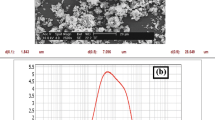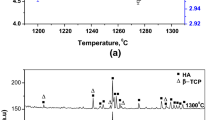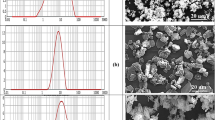Abstract
The effects of increasing bioactive glass additions, SiO2–TiO2–CaO–Na2O–ZnO up to 25 wt% in increments of 5 wt%, on the physical and mechanical properties of hydroxyapatite (HA) sintered at 900, 1000, 1100 and 1200 °C for 2 h was investigated. Increasing both the glass content and the temperature resulted in increased HA decomposition. This resulted in the formation of a number of bioactive phases. However the presence of the liquidus glass phase did not result in increased densification levels. At 1000 and 1100 °C the additions of 5 wt% glass resulted in a decrease in density which never recovered with increasing glass content. At 1200 °C a cyclic pattern resulted from increasing glass content. There was no direct relationship between strength and density with all samples experiencing no change or a decrease in strength with increasing glass content. Weibull statistics displayed no pattern with increasing glass content.














Similar content being viewed by others
References
Kalita S, Bhardwaj A, Bhatt H. Nanocrystalline calcium phosphate ceramics in biomedical engineering. Mater Sci Eng C. 2007;27(3):441–9.
Wang M. Developing bioactive composite materials for tissue replacement. Biomaterials. 2003;24(13):2133–51.
Manley M, Sutton K, Dumbleton J. Calcium phosphates: a survey of the orthopaedic literature. In: Epinette J, Manley M, editors. Fifteen years of clinical experience with hydroxyapatite coatings in joint arthroplasty. 452 New York: Springer; 2003. p. 452.
Itoh S, Kikuchi M, Takakuda K, Koyama Y, Matsumoto H, Ichinose S, et al. The biocompatibility and osteoconductive activity of a novel hydroxyapatite/collagen composite biomaterial, and its function as a carrier of rhBMP-2. J Biomed Mater Res. 2001;54(3):445–53.
Anselme K, Noël B, Flautre B, Blary M, Delecourt C, Descamps M, et al. Association of porous hydroxyapatite and bone marrow cells for bone regeneration. Bone. 1999;25(2, Supplement 1):51S–54S.
Erbe E, Marx J, Clineff T, Bellincampi L. Potential of an ultraporous β-tricalcium phosphate synthetic cancellous bone void filler and bone marrow aspirate composite graft. Eur Spine J. 2001;10(2):S141–6.
Klein C, Driessen A, de Groot K, van den Hooff A. Biodegradation behavior of various calcium phosphate materials in bone tissue. J Biomed Mater Res. 1983;17(5):769–84.
Hayek E, Newesely H, Rumpel M. Pentacalcium Monohydroxyorthophosphate. In: Kleinberg J, editor. Inorganic Syntheses [Internet]. New York: Wiley; 2007. p. 63–5. http://onlinelibrary.wiley.com/doi/10.1002/9780470132388.ch17/summary. Accessed 9 Jun 2013.
Royer A, Viguie J, Heughebaert M, Heughebaert J. Stoichiometry of hydroxyapatite: influence on the flexural strength. J Mater Sci Mater Med. 1993;4(1):76–82.
Ramachandra Rao R. Synthesis and sintering of hydroxyapatite–zirconia composites. Mater Sci Eng C. 2002;20(1–2):187–93.
Ioku K, Yoshimura M, Sōmiya S. Microstructure and mechanical properties of hydroxyapatite ceramics with zirconia dispersion prepared by post-sintering. Biomaterials. 1990;11(1):57–61.
Guo H. Laminated and functionally graded hydroxyapatite/yttria stabilized tetragonal zirconia composites fabricated by spark plasma sintering. Biomaterials. 2003;24(4):667–75.
Sung Y, Shin Y, Ryu J. Preparation of hydroxyapatite/zirconia bioceramic nanocomposites for orthopaedic and dental prosthesis applications. Nanotechnology. 2007;18(6):065602.
Yoshida K. Fabrication of structure-controlled hydroxyapatite/zirconia composite. J Eur Ceram Soc. 2006;26(4–5):515–8.
Rao W, Boehm R. A study of sintered apatites. J Dent Res. 1974;53(6):1351–4.
Jarcho M, Bolen C, Thomas M, Bobick J, Kay J, Adamson R. Hydroxylapatite synthesis and characterization in dense polycrystalline form. J Mater Sci. 1976;11(11):2027–35.
Nagarajan V, Rao K. Structural, mechanical and biocompatibility studies of hydroxyapatite-derived composites toughened by zirconia addition. J Mater Chem. 1993;3(1):43–51.
Hing K, Gibson I, Di-Silvio L, Best S, Bonfield W. Effect of variation in Ca: P ratio on cellular response of primary human osteoblast-like cells to hydroxyapatite-based ceramics. Bioceramics Conference. 1998. p. 293–6.
Curran D, Fleming T, Towler M, Hampshire S. Mechanical properties of hydroxyapatite–zirconia compacts sintered by two different sintering methods. J Mater Sci Mater Med. 2010;21(4):1109–20.
Adolfsson E, Alberius-Henning P, Hermansson L. Phase analysis and thermal stability of hot isostatically pressed zirconia–hydroxyapatite composites. J Am Ceram Soc. 2000;83(11):2798–802.
Li J, Hermansson L, Söremark R. High-strength biofunctional zirconia: mechanical properties and static fatigue behaviour of zirconia–apatite composites. J Mater Sci Mater Med. 1993;4(1):50–4.
Shen Z, Adolfsson E, Nygren M, Gao L, Kawaoka H, Niihara K. Dense hydroxyapatite–zirconia ceramic composites with high strength for biological applications. Adv Mater. 2001;13(3):214–6.
Li W. Fabrication of HAp–ZrO2 (3Y) nano-composite by SPS. Biomaterials. 2003;24(6):937–40.
Choi J, Kong Y, Kim H, Lee I. Reinforcement of hydroxyapatite bioceramic by addition of Ni3Al and Al2O3. J Am Ceram Soc. 1998;81(7):1743–8.
Asmus S, Sakakura S, Pezzotti G. Hydroxyapatite toughened by silver inclusions. J Compos Mater. 2003;37(23):2117–29.
Chaki T, Wang P. Densification and strengthening of silver-reinforced hydroxyapatite-matrix composite prepared by sintering. J Mater Sci Mater Med. 1994;5(8):533–42.
Zhang X, Gubbels G, Terpstra R, Metselaar R. Toughening of calcium hydroxyapatite with silver particles. J Mater Sci. 1997;32(1):235–43.
Nath S, Kalmodia S, Basu B. Densification, phase stability and in vitro biocompatibility property of hydroxyapatite-10 wt% silver composites. J Mater Sci Mater Med. 2010;21(4):1273–87.
Kokubo T, Shigematsu M, Nagashima Y, Tashiro M, Nakamura T, Yamamuro T, et al. Apatite-and wollastonite-containing glass-ceramics for prosthetic application. Bull Inst Chem Res Kyoto Univ. 1982;60(3–4):260–8.
Wren A, Boyd D, Towler MR. The processing, mechanical properties and bioactivity of strontium based glass polyalkenoate cements. J Mater Sci Mater Med. 2008;19(4):1737–43.
Williams J, Billington R. Changes in compressive strength of glass ionomer restorative materials with respect to time periods of 24 h to 4 months. J Oral Rehabil. 1991;18(2):163–8.
Ruys A, Wei M, Sorrell C, Dickson M, Brandwood A, Milthorpe B. Sintering effects on the strength of hydroxyapatite. Biomaterials. 1995;16(5):409–15.
Liu D, Chou H. Formation of a new bioactive glass-ceramic. J Mater Sci Mater Med. 1994;5(1):7–10.
Kokubo T. Bioactive glass ceramics: properties and applications. Biomaterials. 1991;12(2):155–63.
Ravaglioli A, Krajewski A, De Portu G. Problems involved in assessing mechanical behaviour of bioceramics. Bioceramics. 1989;18:13–8.
Xiang Y, Du J, Skinner L, Benmore C, Wren A, Boyd D, et al. Structure and diffusion of ZnO–SrO–CaO–Na2O–SiO2 bioactive glasses: a combined high energy X-ray diffraction and molecular dynamics simulations study. RSC Adv. 2013;3(17):5966.
Wren AW, Keenan T, Coughlan A, Laffir FR, Boyd D, Towler MR, et al. Characterisation of Ga2O3–Na2O–CaO–ZnO–SiO2 bioactive glasses. J Mater Sci. 2013;48(11):3999–4007.
Wren A, Coughlan A, Smale K, Misture S, Mahon B, Clarkin O, et al. Fabrication of CaO–NaO–SiO2/TiO2 scaffolds for surgical applications. J Mater Sci Mater Med. 2012;23(12):2881–91.
Wren A, Akgun B, Adams B, Coughlan A, Mellott N, Towler M. Characterization and antibacterial efficacy of silver-coated Ca–Na–Zn–Si/Ti glasses. J Biomater Appl. 2012;27(4):433–43.
Brook I, Freeman C, Grubb S, Cummins N, Curran D, Reidy C, et al. Biological evaluation of nano-hydroxyapatite–zirconia (HA–ZrO2) composites and strontium–hydroxyapatite (Sr–HA) for load-bearing applications. J Biomater Appl. 2012;27(3):291–8.
Towler M, Hampshire S, Reidy D, Curran D, Fleming T. Comparison of microwave and conventionally sintered yttria doped zirconia ceramics and hydroxyapatite‐zirconia nanocomposites. In: Ohji T, Singh M, editors. Advanced Processing and Manufacturing Technologies for Structural and Multifunctional Materials V: Ceramic Engineering and Science Proceedings. New York: Wiley; 2011.
Williams J, Billington R, Pearson G. The effect of the disc support system on biaxial tensile strength of a glass ionomer cement. Dent Mater. 2002;18(5):376–9.
Quinn J, Quinn G. A practical and systematic review of Weibull statistics for reporting strengths of dental materials. Dent Mater. 2010;26(2):135–47.
Santos J, Knowles J, Reis R, Monteiro F, Hastings G. Microstructural characterization of glass-reinforced hydroxyapatite composites. Biomaterials. 1994;15(1):5–10.
Kangasniemi I, DeGroot K, Wolke J, Andersson O, Luklinska Z, Becht J, et al. The stability of hydroxyapatite in an optimized bioactive glass matrix at sintering temperatures. J Mater Sci Mater Med. 1991;2(3):133–7.
Knowles J, Bonfield W. Development of a glass reinforced hydroxyapatite with enhanced mechanical properties. The effect of glass composition on mechanical properties and its relationship to phase changes. J Biomed Mater Res. 1993;27(12):1591–8.
Kondo N, Ogose A, Tokunaga K, Umezu H, Arai K, Kudo N, et al. Osteoinduction with highly purified β-tricalcium phosphate in dog dorsal muscles and the proliferation of osteoclasts before heterotopic bone formation. Biomaterials. 2006;27(25):4419–27.
Cao W, Hench L. Bioactive materials. Ceram Int. 1996;22(6):493–507.
Hench L. Bioceramics: from concept to clinic. J Am Ceram Soc. 1991;74(7):1487–510.
Georgiou G, Knowles J. Glass reinforced hydroxyapatite for hard tissue surgery—Part 1: mechanical properties. Biomaterials. 2001;22(20):2811–5.
Wu C, Chang J, Zhai W. A novel hardystonite bioceramic: preparation and characteristics. Ceram Int. 2005;31(1):27–31.
Lu H, Kawazoe N, Tateishi T, Chen G, Jin X, Chang J. In vitro proliferation and osteogenic differentiation of human bone marrow-derived mesenchymal stem cells cultured with hardystonite (Ca2ZnSi2O7) and β-TCP ceramics. J Biomater Appl. 2010;25(1):39–56.
Bohner M. Calcium orthophosphates in medicine: from ceramics to calcium phosphate cements. Injury. 2000;31(Supplement 4):D37–47.
Jinawath S, Pongkao D, Suchanek W, Yoshimura M. Hydrothermal synthesis of monetite and hydroxyapatite from monocalcium phosphate monohydrate. Int J Inorg Mater. 2001;3(7):997–1001.
Ryu H, Youn H, Sun Hong K, Chang B, Lee C, Chung S. An improvement in sintering property of β-tricalcium phosphate by addition of calcium pyrophosphate. Biomaterials. 2002;23(3):909–14.
Hessle L, Johnson K, Anderson H, Narisawa S, Sali A, Goding J, et al. Tissue-nonspecific alkaline phosphatase and plasma cell membrane glycoprotein-1 are central antagonistic regulators of bone mineralization. Proc Natl Acad Sci. 2002;99(14):9445–9.
Ooms E, Wolke J, van de Heuvel M, Jeschke B, Jansen J. Histological evaluation of the bone response to calcium phosphate cement implanted in cortical bone. Biomaterials. 2003;24(6):989–1000.
Asami K, Saito K, Ohtsu N, Nagata S, Hanawa T. Titanium-implanted CaTiO3 films and their changes in Hanks’ solution. Surf Interface Anal. 2003;35(5):483–8.
Manso M, Langlet M, Martinez-Duart J. Testing sol–gel CaTiO3 coatings for biocompatible applications. Mater Sci Eng C. 2003;23(3):447–50.
Gou Z, Chang J, Zhai W. Preparation and characterization of novel bioactive dicalcium silicate ceramics. J Eur Ceram Soc. 2005;25(9):1507–14.
Liu X, Xie Y, Ding C, Chu P. Early apatite deposition and osteoblast growth on plasma-sprayed dicalcium silicate coating. J Biomed Mater Res A. 2005;74A(3):356–65.
Zhang M, Zhai W, Chang J. Preparation and characterization of a novel willemite bioceramic. J Mater Sci Mater Med. 2010;21(4):1169–73.
De Aza P, Guitian F, De Aza S. Bioactivity of wollastonite ceramics: in vitro evaluation. Scr Metall Mater. 1994;31(8):1001–5.
Oktar F, Göller G. Sintering effects on mechanical properties of glass-reinforced hydroxyapatite composites. Ceram Int. 2002;28(6):617–21.
Santos J, Reis R, Monteiro F, Knowles J, Hastings G. Liquid phase sintering of hydroxyapatite by phosphate and silicate glass additions: structure and properties of the composites. J Mater Sci Mater Med. 1995;6(6):348–52.
Lopes M, Monteiro F, Santos J. Glass-reinforced hydroxyapatite composites: fracture toughness and hardness dependence on microstructural characteristics. Biomaterials. 1999;20(21):2085–90.
Author information
Authors and Affiliations
Corresponding author
Rights and permissions
About this article
Cite this article
Yatongchai, C., Wren, A.W., Curran, D.J. et al. Investigating the effect of SiO2–TiO2–CaO–Na2O–ZnO bioactive glass doped hydroxyapatite: characterisation and structural evaluation. J Mater Sci: Mater Med 25, 1645–1659 (2014). https://doi.org/10.1007/s10856-014-5215-3
Received:
Accepted:
Published:
Issue Date:
DOI: https://doi.org/10.1007/s10856-014-5215-3




